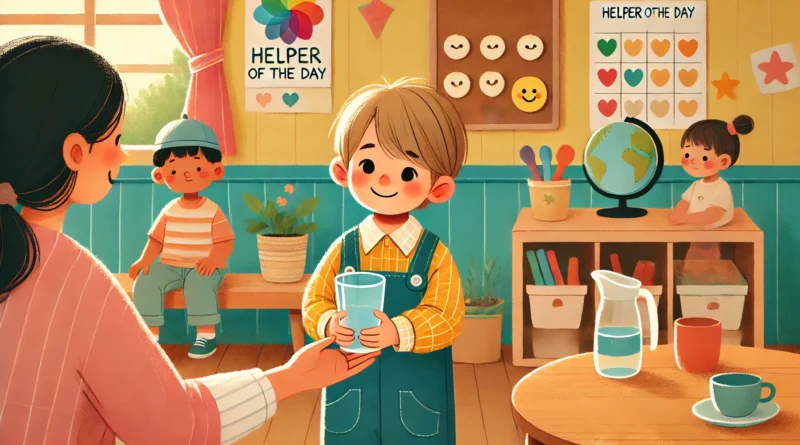How to Teach Young Children About Helping Others
Helping others is one of the first and most powerful ways to teach young children about kindness, empathy, and community. Whether it’s helping a friend clean up or bringing a sibling a snack, children thrive when they feel useful and connected. By creating opportunities to help and celebrating those moments, you can nurture a child’s natural desire to be kind and supportive.
Why Teaching About Helping Matters
- Builds empathy and emotional intelligence
- Encourages cooperation and teamwork
- Fosters responsibility and confidence
- Strengthens family and peer relationships
- Promotes a sense of purpose and belonging
1. Explain What It Means to Help Others
Use simple, relatable language.
Activity Idea:
Say: “Helping means doing something kind for someone else.”
Give examples: “When you hold the door or share a toy, you are helping.”
Ask: “Who did you help today?”
What Kids Learn:
- The meaning of helpful actions
- How their choices affect others
- That helping feels good
2. Set Up Daily Helping Tasks
Make helping part of your routine.
Activity Idea:
Assign small jobs like feeding a pet, passing out napkins, or watering plants.
Use a visual helper chart so they can track their actions.
Rotate tasks to keep it engaging.
What Kids Learn:
- Responsibility in daily life
- Pride in contributing
- Value of teamwork
3. Use Role-Play to Practice Helping
Make learning hands-on and fun.
Activity Idea:
Act out scenes like helping a friend who dropped something or needs comfort.
Use dolls or stuffed animals to show different helping scenarios.
Ask: “What would you do if your friend felt sad?”
What Kids Learn:
- How to respond with empathy
- Creative thinking in problem-solving
- Confidence in kind actions
4. Read Stories That Highlight Helping
Books offer memorable lessons.
Activity Idea:
Read books like The Lion and the Mouse (Aesop’s fable) or The Bear Who Shared by Catherine Rayner.
Discuss how the characters helped each other.
Draw or color a picture of your child helping someone.
What Kids Learn:
- Real-world applications of kindness
- Emotional connection to values
- Models for future behavior
5. Model Helping Behavior Yourself
Show them how it’s done.
Activity Idea:
Let your child see you helping others—like a neighbor, family member, or community member.
Narrate your actions: “I’m bringing soup to Grandma because I want to help her feel better.”
Involve them: “Do you want to carry the spoon?”
What Kids Learn:
- Helping as part of everyday life
- Family values in action
- Pride in working together
6. Celebrate Acts of Kindness
Reinforce their good behavior.
Activity Idea:
Praise: “You were a big helper when you shared with your brother!”
Use a “Helper of the Day” sticker or award.
Reflect at bedtime: “How did you help someone today?”
What Kids Learn:
- That kindness is noticed and appreciated
- Motivation to keep helping
- Joy in being acknowledged
7. Encourage Helping in Group Play
Turn teamwork into fun.
Activity Idea:
During playdates or class time, point out group helping: “You all cleaned up so fast together!”
Set up cooperative games or team challenges.
Celebrate group achievements: “Look what you made together!”
What Kids Learn:
- Social cooperation
- Shared goals and success
- How teamwork strengthens bonds
8. Create a Family Helping Tradition
Make it meaningful and consistent.
Activity Idea:
Choose a regular “Helping Day” each week.
Do something together like making cards for seniors or donating toys.
Make it fun and reflective: “How did it feel to help today?”
What Kids Learn:
- Service as a family value
- Community involvement
- Long-lasting memories tied to kindness
Final Thoughts
Teaching young children about helping others lays the foundation for compassion, responsibility, and connectedness. Through everyday actions, books, stories, and celebrations, you show them that their choices matter—and that being helpful is one of the best things we can do for others and for ourselves.
